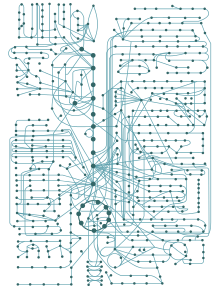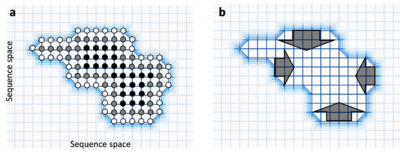Robustness (evolution)
In

Classification
Mutational robustness
Mutational robustness (also called mutation tolerance) describes the extent to which an organism's phenotype remains constant in spite of
Conversely, measured mutational robustnesses of organisms vary widely. For example, >95% of point mutations in
Robustness to stochasticity
Biological processes at the molecular scale are inherently stochastic.[16] They emerge from a combination of stochastic events that happen given the physico-chemical properties of molecules. For instance, gene expression is intrinsically noisy. This means that two cells in exactly identical regulatory states will exhibit different mRNA contents.[17][18] The cell population level log-normal distribution of mRNA content[19] follows directly from the application of the Central Limit Theorem to the multi-step nature of gene expression regulation.[20]
Environmental robustness
In varying
Genetic, molecular and cellular causes

Genomes mutate by environmental damage and imperfect replication, yet they display remarkable tolerance. This comes from robustness both at many different levels.
Organism mutational robustness
There are many mechanisms that provide genome robustness. For example, genetic redundancy reduces the effect of mutations in any one copy of a multi-copy gene.[21] Additionally the flux through a metabolic pathway is typically limited by only a few of the steps, meaning that changes in function of many of the enzymes have little effect on fitness.[22][23] Similarly metabolic networks have multiple alternate pathways to produce many key metabolites.[24]
Protein mutational robustness
Protein mutation tolerance is the product of two main features: the structure of the
Gene expression robustness
During
Furthermore, in developmental contexts were timing of gene expression in important for the phenotypic outcome, diverse mechanisms exist to ensure proper gene expression in a timely manner.[36] Poised promoters are transcriptionally inactive promoters that display RNA polymerase II binding, ready for rapid induction.[38] In addition, because not all transcription factors can bind their target site in compacted heterochromatin, pioneer transcription factors (such as Zld or FoxA) are required to open chromatin and allow the binding of other transcription factors that can rapidly induce gene expression. Open inactive enhancers are call poised enhancers.[39]
Cell competition is a phenomenon first described in Drosophila[40] where mosaic Minute mutant cells (affecting ribosomal proteins) in a wild-type background would be eliminated. This phenomenon also happens in the early mouse embryo where cells expressing high levels of Myc actively kill their neighbors displaying low levels of Myc expression. This results in homogeneously high levels of Myc.[41][42]
Developmental patterning robustness
Patterning mechanisms such as those described by the French flag model can be perturbed at many levels (production and stochasticity of the diffusion of the morphogen, production of the receptor, stochastic of the signaling cascade, etc). Patterning is therefore inherently noisy. Robustness against this noise and genetic perturbation is therefore necessary to ensure proper that cells measure accurately positional information. Studies of the zebrafish neural tube and antero-posterior patternings has shown that noisy signaling leads to imperfect cell differentiation that is later corrected by transdifferentiation, migration or cell death of the misplaced cells.[43][44][45]
Additionally, the structure (or topology) of signaling pathways has been demonstrated to play an important role in robustness to genetic perturbations.[46] Self-enhanced degradation has long been an example of robustness in System biology.[47] Similarly, robustness of dorsoventral patterning in many species emerges from the balanced shuttling-degradation mechanisms involved in BMP signaling.[48][49][50]
Evolutionary consequences
Since organisms are constantly exposed to genetic and non-genetic perturbations, robustness is important to ensure the stability of
Being robust may even be a favoured at the expense of total fitness as an evolutionarily stable strategy (also called survival of the flattest).[52] A high but narrow peak of a fitness landscape confers high fitness but low robustness as most mutations lead to massive loss of fitness. High mutation rates may favour population of lower, but broader fitness peaks. More critical biological systems may also have greater selection for robustness as reductions in function are more damaging to fitness.[53] Mutational robustness is thought to be one driver for theoretical viral quasispecies formation.

Emergent mutational robustness
Robustness and evolvability
Mutational robustness has been thought to have a negative impact on evolvability because it reduces the mutational accessibility of distinct heritable phenotypes for a single genotype and reduces selective differences within a genetically diverse population.[citation needed] Counter-intuitively however, it has been hypothesized that phenotypic robustness towards mutations may actually increase the pace of heritable phenotypic adaptation when viewed over longer periods of time.[64][65][66][67]
One hypothesis for how robustness promotes evolvability in asexual populations is that connected networks of fitness-neutral genotypes result in mutational robustness which, while reducing accessibility of new heritable phenotypes over short timescales, over longer time periods, neutral mutation and genetic drift cause the population to spread out over a larger neutral network in genotype space.[68] This genetic diversity gives the population mutational access to a greater number of distinct heritable phenotypes that can be reached from different points of the neutral network.[64][65][67][69][70][71][72] However, this mechanism may be limited to phenotypes dependent on a single genetic locus; for polygenic traits, genetic diversity in asexual populations does not significantly increase evolvability.[73]
In the case of proteins, robustness promotes evolvability in the form of an excess free energy of folding.[74] Since most mutations reduce stability, an excess folding free energy allows toleration of mutations that are beneficial to activity but would otherwise destabilise the protein.
In sexual populations, robustness leads to the accumulation of cryptic genetic variation with high evolutionary potential.[75][76]
Evolvability may be high when robustness is reversible, with evolutionary capacitance allowing a switch between high robustness in most circumstances and low robustness at times of stress.[77]
Methods and model systems
There are many systems that have been used to study robustness. In silico models have been used to model
See also
- Distribution of fitness effects
- Evolvability
- Canalization
- Neutral network (evolution)
- Epistasis
- Evolutionary capacitance
- Fitness landscape
- Evolutionary developmental biology
References
- S2CID 7644586.
- S2CID 14214978.
- PMID 17167519.
- S2CID 4127926.
- S2CID 221736785.
- PMID 21840371.
- PMID 21466836.
- PMID 20932875.
- ^ ISBN 0-691-12240-7.[page needed]
- ^ PMID 20478892.
- S2CID 10868777.
- ^ PMID 21464309.
- ^ PMID 15197260.
- ^ PMID 10481013.
- ^ PMID 16738554.
- )
- S2CID 10845628.
- S2CID 4347106.
- PMID 16204192.
- S2CID 31138796.
- S2CID 4348693.
- PMID 14580578.
- PMID 22936779.
- PMID 11818563.
- PMID 11786027.
- PMID 19765975.
- PMID 17596339.
- PMID 21685880.
- S2CID 24638570.
- PMID 15741509.
- PMID 17668004.
- PMID 9502314.
- PMID 11880627.
- PMID 23300488.

- PMID 23754851.
- ^ PMID 22513408.
- PMID 20797865.
- PMID 17994019.
- PMID 22028675.
- PMID 1116643.
- S2CID 4414411.
- PMID 23867226.
- PMID 23622240.
- PMID 31624259.
- PMID 32439756.
- PMID 14536064.
- PMID 18364710.
- S2CID 4397746.
- PMID 25772352.
- )
- PMID 19717203.
- S2CID 1482925.
- PMID 22295094.

- PMID 10449760.
- PMID 16248678.

- PMID 17110488.
- ^ PMID 17640347.

- ^ PMID 18495157.
- .
- PMID 11069142.
- S2CID 8935948.
- PMID 28565347.
- PMID 20140261.

- ^ PMID 20090752.
- ^ PMID 17971325.
- PMID 20598394.
- ^ PMID 17188715.
- .
- PMID 9261065.
- S2CID 17930325.
- PMID 17690244.
- S2CID 10651547.
- PMID 23335336.
- PMID 16581913.
- ^ Waddington CH (1957). The strategy of the genes. George Allen & Unwin.
- PMID 16387877.
- PMID 24228631.

- S2CID 248313305.
- PMID 35264797.
